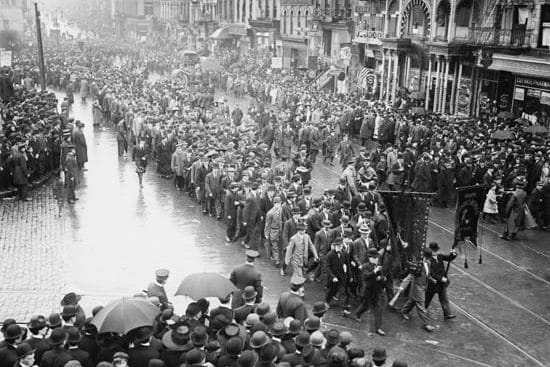“War to the palace, peace to the cottage, and death to luxurious idleness! The wage system is the only cause of the world’s misery. It is supported by the rich classes, and to destroy it they must be either made to work or die. One pound of dynamite is better than a bushel of ballots! Make your demand for eight hours with weapons in your hands to meet the capitalist bloodhounds—police and militia—in a proper manner.”
These words appeared in The Alarm—one of the most prominent anarchist newspapers during the late 1880’s—on April 24, 1886. A few days later, on May 1, over 300,00 workers across the U.S. went on strike to agitate for the 8-hour workday and protest against the theft inherent in the capitalist mode of production. In Chicago, historians estimate that around 40,000-60,000 workers went on strike. In subsequent days, the striking workers were estimated to be around 100,000. On May 3, workers and police violently clashed. In the violence, two workers were killed.
The following day, workers showed up to Haymarket Square in Chicago in response to the previous days’ murders. The turnout was far less than expected, anywhere from a few hundred to 3000 people. The mayor of Chicago attended the rally and famed labor leader August Spies spoke at the rally. However, toward the end of the rally when the mayor left, around 180 police stormed the gathering. During the melee, a bomb exploded. The origins of the bomb are still unknown, but it killed one police officer. Six other officers died from gun fire (that historians now agree was due to gun fire from other officers). Four workers died in the chaos. The day after May 4, martial law was declared in Chicago. Police went door to door conducting warrantless searches of countless dissidents and harassed anyone they thought may be sympathetic to the anarchists. Police discarded constitutional restraint over the next eight weeks in their crackdown on labor leaders and search for the alleged bomb thrower(s).
Eventually, eight anarchists were rounded up and indicted for the murder of police officer Mathias Degan. The eight included August Spies, Albert R. Parsons (married to revolutionary Lucy Parsons), Louis Lingg, Michael Schwab, Samuel Fielden, George Engel, Adolph Fischer, and Oscar Neebe.
During the course of the trial, it was clear that the prosecution had no idea who actually threw the bomb or even if it was one of the eight who had been indicted.[1] Some of those indicted were not even at the rally on May 4. Instead, the prosecution alluded to alleged past statements made by the anarchists that advocated for revolution. The trial, according to most accounts, was nothing short of a sham designed to convict the eight accused and deprive them of any semblance of due process. Indeed, all eight were convicted. Seven were sentenced to death by hanging and one to a prison term of 15 years. Of the seven sentenced to death, four were hung, two had their sentences commuted to life in prison, and one killed himself while in custody.
In 1893, Illinois governor John Peter Altgeld—a progressive who later refused to authorize President Cleveland’s decision to disrupt the Pullman Strike by force—pardoned the last three living Haymarket Anarchists. Altgeld reviewed the case of the Haymarket martyrs and noted several reasons to issue the pardon:
- The jury was appointed by a special bailiff (rather than the random selection that was the normal course for criminal procedure in Chicago at the time). The bailiff, Altgeld, wrote, “boasted…that these fellows would hang as certain as death.” The bailiff also reportedly bragged about his strategy to pick such jurors that the defense would have no choice but to exhaust all peremptory challenges. During the jury “selection,” several of the selected jurors openly admitted that they had concluded the anarchists were guilty before the trial had started and that they would likely not change their opinion.
- “The State has never discovered who it was that threw the bomb which killed the policeman, and the evidence does not show any connection whatever between the defendants and the man who did throw it.”
- The jurors were incompetent by the standards set by the U.S. Supreme Court.
- The Chief of Police admitted that one of his Captains (Cap. Schaack) “wanted to send out men to have other conspiracies formed, in order to get the credit of discovering them, and keep the public excited.” The Chief also noted that Cap. Schaack, after breaking up the “anarchist societies,” wanted to create new ones “to keep the thing boiling—keep himself prominent before the public.”
- Eyewitness testimony of police was contradicted by numerous journalists and other individuals unaffiliated with the anarchists that were much closer in place to the alleged site of the bomb thrower.
- The State’s attorney, according to then-Mayor of Chicago and several others, admitted at the time of trial that he did not have a case against Neebe and wanted to drop the case against Neebe. However, the State’s Attorney was persuaded to keep Neebe in the case. Corporate counsel for the City of Chicago, F.S. Winston also stated, in 1889, that he “never believed there was sufficient evidence to convict Mr. Neebe, and so stated during the trial.”[2]
- Altgeld also noted several additional procedural defects including the trial court’s failure to guard against irrelevant and prejudicial evidence brought by the state, failure allow sufficient cross-examination of state’s witnesses by the defense, personal attacks on defense attorneys by the court, and that “every ruling throughout the long trial on any contested point, was in favor of the state.” The governor declared that the speeches made from the judge’s bench “were much more damaging than any speeches from the State’s Attorney could possibly have been[.]”
The fate of the Haymarket martyrs revealed a fact that anarchists, communists, and other dissidents in this country have known too well for too long (especially after Haymarket): that the State guarantees of due process, a trial by jury, of equal rights before the law, etc. will be discarded if such dissidents ever obtain even a shred of power that could upset power relations between the governed and those that govern—between the rich and poor.
72 years after May Day 1886, President Eisenhower, at the behest of his legal Counsel, Charles S. Rhyne, declared May 1 to be “Law Day.” The declaration was seen by many as an attempt to blunt and distract traditional observance of May Day. Rhyne noted that the purpose of Law Day is to express “to the people of the world our admiration and respect for the rule of law as the key to individual freedom and justice.” Of course, this “expression” was just another propaganda tool to advance the imperialist agenda of the U.S. at that time. The U.S was not—and still is not—governed by anything remotely close to the conservative idealist notion of the “Rule of Law.” Indeed, one would be hard-pressed to even find a politician or bureaucrat to define the notion beyond self-reference.
This is not the State’s only attempt to subdue May Day activity. Prior to Law Day, U.S. Congress, in a fit of reactionary outrage at the “communist threat,” urged the President to declared May 1 as “Loyalty Day.” The day was commemorated specifically to counter May Day.[3]
In both Law Day and Loyalty day, there was a clear attempt to conflate democracy with capitalism and communism/socialism with despotism. The holidays represent some of the more overt propaganda attempts by the U.S. to demonize the various anti-capitalist projects of anarchists, communists, and socialists. By now, though, it is clear that capitalism represents and aids the most despotic and destructive tendencies in human society. Overall, it has been a failure for humankind and a disaster for the planet. The old socialist regimes certainly had their share of despotism, but the systematic disenfranchisement of billions by the capitalist class and the destruction of the environment has brought (and is sure to bring) greater suffering than could be imagined under the antiquated regimes of the U.S.S.R. and other so-called “communist” regimes.
Looking forward to this May Day, we should remember that democracy is not the political expression and organization of capital—rather, it is capital that organizes us under the appearance of democracy—eventually overturning any democratic practices in favor of those with the most capital. To achieve democracy, we must save ourselves from capital. It won’t happen in one day, but we should guard against attempts to erase the history of struggle against capital.
[1] John P. Altgeld, “Reasons for Pardoning Fielden, Neebe & Schwa, The Haymarket Anarchists.” New York: New York Labor News co. (1894). https://archive.org/details/govaltgeldspardo00illi
[2] Id.
[3] Los Angeles Times Editorial Board, “Not to be a downer, but here’s a reality check on ‘Loyalty Day.’” April 29, 2016. Accessed April 30, 2018. http://www.latimes.com/opinion/editorials/la-ed-0429-loyalty-day-20160429-story.html

